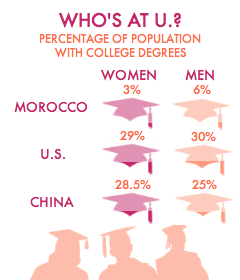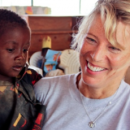
November 21, 2012 | Education
Woman of the Week: Carolyn Miles

Woman of the Week Carolyn Miles is the President and CEO of Save the Children, an organization that creates change in the lives of children in the United States and 120 countries around the world. After joining the organization in 1998 and serving as its Chief Operating Officer, Carolyn became the first woman to head Save the Children in September 2011.
Carolyn is a member of the Board of Directors of Blackbaud, a major supplier of nonprofit software, and is the chair of the Nominations/Governance Committee. In addition, she serves on the Board of the University of Virgina’s Darden School of Business, where she received her MBA.
After initially working in the private sector, Carolyn brought her entrepreneurial spirit to Save the Children to provide the world’s children with better opportunities in life. Carolyn talks with the Women in the World Foundation about how her career developed over time, how girls need access to education, and how social media helps Save the Children.
After starting your career in business, how did you end up working at Save the Children?
I took an unusual path to Save the Children. In my childhood, I lived in a suburb of Pittsburgh in a distinctly family-oriented place. Family matters a lot there, and several of my childhood friends never left. Growing up in this environment gave me a great sense of how important it is for children to have a loving presence in their lives.
As an undergrad at Bucknell, I studied Animal Behavior, which gave me insight into human behaviour as well, and graduated from University of Virginia’s Darden School of Business in Charlottesville. I went on to work for American Express, first in New York and later in Asia. I then focused on entrepreneurship, launching a chain of retail coffee shops across Asia. But while I was living in Asia with my husband and our first two children, we did a lot of traveling—and I was constantly struck by the stark contrast between the opportunities my boys would have and the likely future of the poor children I met in Asian countries. It simply wasn’t fair that an accident of birth meant they would have to fight so hard to access basic things like food, education and security—things that every child should have. That’s when I decided to turn my focus on what I could do to contribute to a better world for all kids, not just my own.
Who are some women who have really influenced or inspired you?
There are a lot of inspiring women in my field but I do find the woman who founded Save the Children, Eglantyne Jebb, to be inspirational to me. She believed children had rights, at a time even before she had the right to vote. She was a visionary – and by the sound of her story, she was probably considered a little crazy as well!
In addition, I hugely admire Hillary Clinton—not just because she manages a demanding job and schedule with integrity, grace and incredible stamina, but because she keeps the human factor front-and-center in everything she does. She has been an outstanding champion for women’s rights and eloquently conveys the message that women are key drivers of a country’s development and progress. A strong woman like Secretary Clinton is not only a role model for those of us working to improve the world on a global scale, but for every woman who is fighting to build a better future for the generations of women who will come after her. It’s a legacy she will leave long after she quits public office.
Based on your previous experiences, what is your best advice for young women looking to engage in some kind of activist work in their careers?
I have found that following a road that’s a bit riskier – whether it was taking my career to Asia, leaving a big company to start up something new, or switching to the non-profit world with zero experience – always worked out. I think it’s because you learn the most when you know the least. So challenge yourself and don’t be afraid to take risks.
What obstacles do women and girls face today?
Women are facing their biggest obstacle long before womanhood—rather, when they are still girls. Many girls do not attend school as long as their male peers, leaving to marry and become mothers at a dangerously early age or because their families do not see the benefit of paying for a girl to continue her education. There has been remarkable progress in girls’ education in the past several years, but there is still so much more to be done to help girls get an equal opportunity in life. Investing in a girl early on and keeping her in school not only improves her chances to develop and provide for her family, but it also contributes to her community and country’s economy. According to the Women’s Learning Partnership, a country’s wages rise by an astonishing 20 percent for every year beyond fourth grade that girls stay in school. And an educated woman places a higher value on education for her own children—helping shape the next generation. So I ask, how can we afford NOT to educate girls!
If you could pass one law for women, what would it be?
There are still many places in the world where women have no right to land or inheritance when a husband dies. Changing this would instantly empower tens of thousands of women to start new lives for themselves and their families.
You keep a regularly updated blog about your experiences with Save the Children. How does Save the Children use this and other social media to enhance and share the work that you are doing?
We serve children and communities all over the United States and in 120 countries around the world, so social media is the best way for us to connect our supporters with the people we’re helping. We can share photos, videos and stories from the field with a touch of a button. Ours is a very human business—it’s all about people reaching out to other people—and social media helps us foster conversation about how we can all make children’s lives better.
My blog, Logging Miles, is a great way to share some of my experiences from my travels to the field, conversations with policymakers and new advances in children’s health and opportunity. And since I’m nearly always writing my blog on a plane or an airport terminal, it’s certainly true to its name! But the best part of the blog is that it isn’t just about how an event or an announcement or a trip overseas can impact Save the Children, but also how they impact me personally. Because, when it comes down to it, the nature of this job—and all of my interactions with children and the people working so hard to help them—is personal. It’s wonderful to be able to share this with supporters who are about children, too.